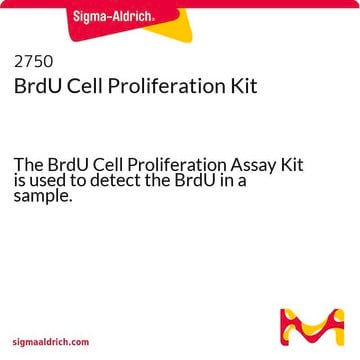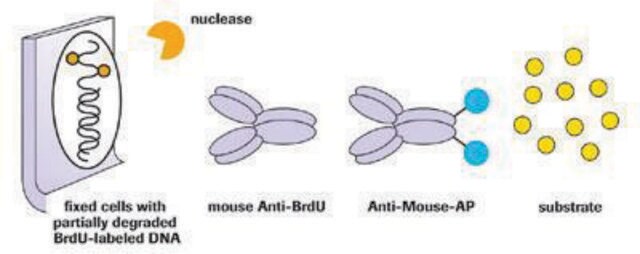QIA58
BrdU Cell Proliferation Assay
This proliferation assay is a non-isotopic immunoassay for quantification of BrdU incorporation into newly synthesized DNA of actively proliferating cells.
Sinonimo/i:
Bromodeoxyuridine Assay
About This Item
Prodotti consigliati
Livello qualitativo
impiego
sufficient for 1000 tests
sufficient for 200 tests
Confezionamento
pkg of 1 96-well plate(s)
Produttore/marchio commerciale
Calbiochem®
Condizioni di stoccaggio
OK to freeze
avoid repeated freeze/thaw cycles
input
sample type intact cells
sample type intact cells
Metodo di rivelazione
colorimetric
Condizioni di spedizione
wet ice
Temperatura di conservazione
−20°C
Categorie correlate
Descrizione generale
Componenti
Attenzione
Specifiche
Principio
Stoccaggio e stabilità
Prior to use:
1. Remove the Fixative/Denaturing Solution and place at room temperature for at least 4 h prior to use. Precipitates that may occur while cold should go back into solution.
2. Reconstitute the Peroxidase Goat Anti-Mouse IgG with the appropriate volume of 1X PBS.
• For the 200 test kit, reconstitute Peroxidase Goat Anti-Mouse IgG in 125 µl of 1X PBS. Use Conjugate Diluent for any further lot-specific dilution.
• For the 1000 test kit, reconstitute Peroxidase Goat Anti-Mouse IgG in 250 µl of 1X PBS. Use Conjugate Diluent for any further lot-specific dilution.
Allow solution to stand at room temperature for 10 min. (or until solution is clear). Divide into small aliquots; aliquots not to be used that same day should be stored at -20°C in a non-frostfree freezer.
Once the kit components have been thawed for use:
• The BrdU label and 100X Anti-BrdU Antibody should be divided into small aliquots and stored at -20°C in a non-frostfree freezer with the Peroxidase Goat Anti-Mouse IgG; avoid multiple freeze/thaw cycles.
• All the other kit components (Substrate, Antibody Diluent, Conjugate Diluent, 20X Plate Wash Concentrate, Fixative/Denaturing Solution, Stop Solution) should be stored at 4°C.
Altre note
Muir, D., et al. 1990. Analytical Biochemistry185, 377.
Lanier, T. L., et al. 1989. Carcinogenesis10, 1341.
Magaud, J.-P., et al. 1988. J. Immunol. Methods106, 95.
Collins, S.J. 1987. Blood70, 1233.
Porstmann, T., et al. 1985. J. Immunol. Methods82, 169.
Raza, A., et al. 1985. Cytometry6, 633.
Morstyn, G., et al. 1983. J. Clin. Invest.72, 1844.
Gratzner, H.G. 1982. Science218, 474.
Note legali
Avvertenze
Danger
Indicazioni di pericolo
Consigli di prudenza
Classi di pericolo
Carc. 2 - Eye Irrit. 2 - Flam. Liq. 2 - Met. Corr. 1 - Muta. 1B - Repr. 2 - Skin Irrit. 2 - Skin Sens. 1
Codice della classe di stoccaggio
3 - Flammable liquids
Punto d’infiammabilità (°F)
69.8 °F
Punto d’infiammabilità (°C)
21 °C
Certificati d'analisi (COA)
Cerca il Certificati d'analisi (COA) digitando il numero di lotto/batch corrispondente. I numeri di lotto o di batch sono stampati sull'etichetta dei prodotti dopo la parola ‘Lotto’ o ‘Batch’.
Possiedi già questo prodotto?
I documenti relativi ai prodotti acquistati recentemente sono disponibili nell’Archivio dei documenti.
I clienti hanno visto anche
Articoli
Quality control guidelines to maintain high quality authenticated and contamination-free cell cultures. Free ECACC handbook download.
Il team dei nostri ricercatori vanta grande esperienza in tutte le aree della ricerca quali Life Science, scienza dei materiali, sintesi chimica, cromatografia, discipline analitiche, ecc..
Contatta l'Assistenza Tecnica.













